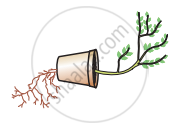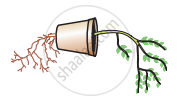Advertisements
Advertisements
Question
A potted plant is growing in a transparent glass jar. In this plant, X and Y are the two growing parts having a lot of meristematic tissue. It is observed that the part X of this plant exhibits positive geotropism but negative phototropism. On the other hand, part Y of this plant exhibits negative geotropism but positive phototropism.
(a) Name the part X of plant.
(b) Name the part Y of plant.
(c) Which part of the plant, X or Y, will exhibit positive hydrotropism?
(d) Which part of the plant, X or Y, can have tendrils on it?
(e) Which phytohormone causes the part X to exhibit negative phototropism?
Solution
(a) The part X is the root.
(b) The part Y is the shoot.
(c) The part X (root) will exhibit positive hydrotropism.
(d) The part Y (shoot) could have tendrils on it.
(e) The phytohormone, auxin causes the root to exhibit negative phototropism.
APPEARS IN
RELATED QUESTIONS
What does a root do in response to light? What is this phenomenon known as?
What does a tendril do in response to the touch of a support? What is this phenomenon known as?
Define chemotropism.
Give one example of a plant part which is positively phototropic but negatively geotropic.
To which directional stimuli do roots respond?
P and Q are two types of plants having weak stems which cannot stand upright on their own. The plants P and Q have organs R and S respectively which can grow towards any support which they happen to touch and wind around that support. It is observed that organ R originates from the leaves of the plant whereas organ S originates directly from the stem of the plant.
(a) What is (i) R, and (ii) S?
(b) What is the name of growth movement exhibited by the organs R and S?
(c) Name the stimulus involved in this case.
(d) State whether the behaviour of organs R and S is a tropic movement or a nastic movement.
(e) Name one plant like P and another plant like Q.
In the given figure (a), (b) and (c), which appears more accurate and why?
 |
 |
 |
| (a) | (b) | (c) |
Plants exchange gases ______ continuously through these stomata.
Observe the three figures given below. Which of the following depicts tropic movements appropriately?
 |
 |
 |
| A | B | C |
Which parts of a plant exhibit Positive hydrotropism?
